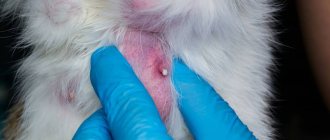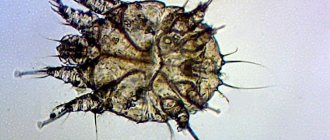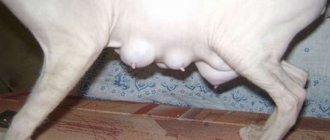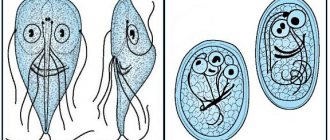Symptoms of stomatitis in cats
The first symptom of feline stomatitis that you may notice is your cat's bad breath. This may be accompanied by excessive drooling/drooling or you may notice that your cat isn't grooming itself as much.
You may also see your cat dropping food from its mouth or crying while eating. Some cats become so sick that they are hesitant to eat and may avoid food to the point that they begin to lose weight.
Help at home
Independent actions are possible with the initial form of stomatitis or with high competence/experience of the cat owner. If the nature of the disease is in question and you are not confident in your own abilities, you should contact the clinic.
Oral examination
This is the first thing to do if you notice strange behavior in your cat. Perform the manipulations slowly, constantly talking to the animal.
Procedure algorithm:
- Examine the teeth and gums by carefully lifting/lowering your pet's lips.
- Then look into the mouth, holding the cat by the head (with the upper jaw) so that your thumb and middle finger are placed at the corners where the jaws meet.
- Lightly press on the edge (without teeth) and the cheek so that it falls slightly into the mouth. So the cat will reflexively open its mouth.
- Using the thumb of your other hand, holding your chin, lightly press on the incisors of the lower jaw.
- If everything is done correctly, the mouth will be as accessible as possible for inspection.
This is interesting! If you see a large affected area, which indicates ulcerative/gangrenous stomatitis, take your cat to the doctor. In case of deep stomatitis, local treatment is not enough: antibiotics or surgical methods will be needed.
Detection of tartar will also require dental intervention.
First aid
It is within your power to remove traumatic foreign bodies (bones, thorns) from the mouth. If it doesn’t work, take the animal to the clinic. If you are sure that you are dealing with primary stomatitis, which does not have serious pathologies behind it, rinse your mouth with a spray bottle, a syringe without a needle, or a rubber bulb.
Recommended liquids:
- strong infusions (sage, string, oak bark, chamomile);
- methylene blue solution;
- alcohol tincture of calendula (1 teaspoon per 10 teaspoons of water);
- solution of soda (1 tsp per 1 liter of warm water);
- hydrogen peroxide (3%);
- solution of furatsilin or potassium permanganate (0.1 g per 0.5 l of water).
This is interesting! When irrigating, the stream is directed to the surface of the gums, slightly tilting the pet’s head forward. The liquid itself will spread throughout the oral cavity, so do not pour anything into the mouth, if necessary, treat only the tongue.
Antiseptic rinses are done twice a day, usually after each meal.
Oral disinfection
Other medications will also help get rid of wounds/weeping ulcers:
- Lugol's solution with glycerin or Lugol's spray;
- Protargol solution (1-5%) – for mouth irrigation or spot cauterization;
- a mixture of 1 part iodine/4 parts glycerin;
- dentavedin gel - applied in a thin layer to the gums 2-3 times a day or placed in the sockets after tooth extraction;
- chlorhexidine (0.05%) - for mouth irrigation or treatment of wounds/ulcers.
Important! Metrogyl denta gel is applied in a thin layer to areas of inflammation/ulceration. An overdose is not allowed, otherwise side effects will occur - thirst, refusal to eat and digestive disorders, including vomiting.
Diet
A strict diet (with access to water, but not food) is recommended when extensive and deep ulcers are detected . In this case, you can rinse the cat’s mouth and give the cat a therapeutic fast for no more than a day until you get to the veterinarian.
Rough food is removed from the diet, replacing dry food with wet food or soaking the granules in warm water. Instead of meat/fish pulp, give porridges, mousses, purees and soups, making sure that the food is lukewarm. From fermented milk products, acidophilus is indicated.
Return to content
How do veterinarians diagnose stomatitis in cats?
Veterinarians diagnose stomatitis in cats primarily through a thorough examination of the mouth.
Severe inflammation of the gums (gum) along with severe inflammation of the inside of the cheeks (the lining of the cheeks) and the back of the mouth (the tail of the oropharynx) is usually a diagnostic sign of stomatitis.
Many patients experience both tooth resorption and inflammation of the bones around the teeth (periodontitis).
Symptoms of the disease
Cat owners should know the main symptoms of the disease, which can be used to suspect this oral disease in their animal. Each type of stomatitis has its own characteristic signs; we list the main ones.
10 signs of stomatitis
- The cat washes itself frequently and rubs its mouth vigorously as if something is bothering it.
- Increased salivation appears.
- The animal is thirsty. The cat drinks all the time.
- Appetite drops. The pet refuses its favorite treats.
- The lymph nodes in the lower jaw are enlarged.
- An unpleasant odor appears from the oral cavity.
- Hyperthermia. Body temperature rises.
- The cat sleeps a lot, becomes lethargic, and refuses active games.
- Saliva turns pink.
- Pus is released. Ulcers form in the mouth.
Important!
If you find signs of pathology in your pet, you must immediately show the animal to a specialist who knows what stomatitis looks like in a cat.
Treatment of stomatitis in cats
To successfully treat feline stomatitis, it is necessary to reduce the number of bacteria in the cat's mouth as much as possible.
This can rarely be achieved with home dental care or pain management alone, as even small amounts of bacteria or plaque may be visible in cats with severe stomatitis.
In fact, cats with stomatitis often have severe inflammation that does not go away or quickly returns after a thorough dental cleaning by a veterinarian.
Currently, the recommended treatment is surgery to remove partial or complete teeth.
While this may seem like a drastic measure, it is currently the best way to achieve significant, long-term comfort for affected cats.
Causes of the disease
In veterinary medicine, stomatitis is understood as a group of inflammatory diseases of the mucous membrane, tongue, and periodontal areas. Pathology can occur in two forms - primary and secondary.
Factors that provoke primary stomatitis include:
- poor oral hygiene;
- injuries to the oral mucosa, for example, when eating tubular bones;
- eating food that is too hot or cold;
- burns of the mucous membrane resulting from contact with aggressive substances, detergents, etc.
Among the causes of secondary stomatitis, veterinarians identify:
- viruses that have entered the body;
- hormonal disorders;
- diabetes;
- infectious diseases.
Stomatitis can develop in any cat, regardless of age and gender; representatives of short-nosed breeds (Persians, exotics) are most susceptible to inflammatory processes in the oral cavity. This is explained by the specific structure of the muzzle.
Recovery and treatment of stomatitis in cats
Studies have shown that 90% of cats who undergo partial or complete tooth extraction experience complete resolution of symptoms.
Cats that eat solid food should be switched to canned foods before surgery and should be on a soft diet for at least two to three weeks after tooth extraction.
For cats that are hesitant to eat during the first few days after surgery, your veterinarian may prescribe an appetite stimulant.
Your veterinarian will also provide you with medications to take home for post-operative pain and inflammation.
Once the gum tissue has healed, many cats are willing and able to eat kibble again. And cat owners often see rapid improvements in their cats' attitude, appetite, and quality of life when their mouths are free of pain and inflammation caused by canker sores.
Treatment, prognosis
Treatment can be conservative (medication), surgical or combined.
Surgical treatment is carried out in severe cases when the mucous membrane has undergone destructive changes without the possibility of recovery. Gangrenous areas will prevent healthy tissue from healing. Often, a specialist also has to remove teeth (in case of autoimmune stomatitis), choosing this method as the only one capable of saving the animal’s life.
A combined treatment method involves surgical cleaning of the oral cavity, removal of certain teeth that are no longer possible to save, and drug therapy.
Medication assistance includes the following steps:
- cleaning the oral mucosa from traces of tissue decay and pus;
- elimination of the source of infection (with secondary stomatitis);
- healing of affected areas of the mucosa;
- strengthening the immune system.
To disinfect the oral cavity and treat ulcers directly, drugs such as Lugol spray, or Lugol's solution with glycerin, Chlorhexidine, Dentavedin gels, Metrogyl, Protargol solution are most often used.
Important: Veterinarians prefer not to use Rotocan, as it provokes hypersalivation.
To eliminate infection and relieve inflammation, antiviral, antifungal, antimicrobial drugs, as well as antibiotics are used.
As for the forecasts, for the most part they are favorable. If the visit to the veterinary clinic was timely, and the treatment was competent and consistent, then it is possible to achieve a complete cure for the animal.
Frequently Asked Questions About Stomatitis in Cats
Can stomatitis in cats be cured?
Canker sores in cats are curable in the sense that surgical removal of the teeth and affected bone can lead to complete resolution of pain and inflammation in the mouth, but there are no other medications or treatments that can offer a true cure for this condition.
How long can a cat live with stomatitis?
Cats affected by stomatitis can live with the condition for many years, but their quality of life may be seriously affected.
The relentless pain caused by canker sores can cause changes in everything from your cat's behavior to a reluctance to eat, leading to sudden weight loss.
Cats that receive proper treatment for canker sores through partial or complete tooth extractions live the happier, healthier, and pain-free lives they deserve.
What should I do if my cat has stomatitis?
If your cat has been diagnosed with canker sores, work with your veterinarian to develop a plan for when and how your cat can have the necessary dental extractions.
Just like in humans, major dental surgery in pets can be expensive, so make sure your plan includes a cost estimate so you're prepared to budget accordingly.
Why do cats get stomatitis?
Unfortunately, we do not know why cats get stomatitis. There is currently no evidence to support a specific cause. What is known is that this is an abnormal reaction of the immune system.
Is stomatitis contagious in cats?
No. Stomatitis is an abnormal overreaction of an individual cat's immune system and is therefore not contagious.
Types of stomatitis
In veterinary medicine, several subtypes of stomatitis are distinguished depending on the nature, cause of occurrence, location of lesions and the clinical picture of inflammation.
Classification by location
Depending on the area of localization, stomatitis is divided into:
- Gingivostomatitis. It is characterized by a gradual spread of the lesion. The mucous membranes of the entire mouth and gums become inflamed.
- Glossitis. The focus of localization is the tongue.
- Faucite. Inflammation of the palatoglossal arch.
- Palatinite. The focus of the lesion is the palate.
- Gingivitis. Inflammatory phenomena are localized on the gums.
- Cheilitis. The focus of localization is the lips.
Classification according to the nature of inflammation
According to the severity and nature of the inflammatory processes, stomatitis can be:
- Alternative. At the site of inflammation, tissue destruction processes predominate.
- ulcerative Characterized by the appearance of weeping ulcers on the mucous membranes of the oral cavity;
- necrotic. Complication of ulcerative. Characterized by tissue death.
- Exudative. It is characterized by redness of the mucous membranes and the release of fluid (exudate) from small blood vessels.
- catarrhal The most common form of pathology. Inflammation is manifested by redness and soreness of the gums, swelling, an unpleasant odor from the animal’s mouth, and excessive salivation;
- serous. There is a white or yellowish coating in the animal’s mouth;
- purulent. Abscesses, boils, fistulas, and carbuncles form in the oral cavity. Pus is released;
- gangrenous (putrefactive). Develops as a complication of ulcerative disease. Characterized by a fetid odor;
- fibrinous. White exudate has a protein structure;
- hemorrhagic. The secreted liquid has a reddish color.
- Proliferative (productive). In the area of inflammation, active cell proliferation occurs, which leads to the proliferation of connective tissues. This type of stomatitis is extremely rare.
In veterinary medicine, mixed types of inflammation of the exudative type are distinguished: catarrhal-purulent, serous-fibrinous, purulent-fibrinous, serous-purulent, purulent-hemorrhagic.
Classification by origin
Depending on the cause of occurrence, there are:
- Primary. Appears as a result of the action of the cause of the pathology on the oral mucosa.
- traumatic;
- chemical;
- thermal.
- Secondary. Develops as a complication of other diseases.
- papillomatous (viral);
- fungal;
- infectious;
- hormone;
- endocrine;
- uremic;
- food, allergic;
- autoimmune.
Classification according to the course of the disease
According to the course of the disease, stomatitis can be acute (up to 2 weeks), subacute (from 2 to 6 weeks), chronic (over 6 weeks). Acute and subacute forms are characterized by a pronounced clinical picture. A chronic disease has a vague clinical picture and provokes the appearance of a general malaise in the animal.
Diagnosis of calcivirosis
The veterinarian makes a diagnosis based on data obtained during an examination of the animal, as well as on the basis of laboratory tests of discharge from the eyes and nose. The main diagnostic methods are PCR and immunohistochemical staining.
If lameness is present, the veterinarian will take an x-ray to rule out injury to the limbs.
If a cat owner tells the veterinarian that the cat has a chronic runny nose, the doctor may order blood and urine tests to determine the cause of the cat's nasal congestion. Sometimes an x-ray of the chest and skull is prescribed.
Eosinophilic granuloma
Eosinophilic granuloma is a series of pathologies united by a common etiology and is characterized by specific formations and inflammation of the skin and mucous membrane. The etiology of the disease has not been studied.
The accumulation of eosinophilic cells suggests that pathological changes are due to immune-mediated or allergic reactions (local or systemic).
There are several clinical syndromes:
Eosinophilic (indolent) ulcer - the most common of all syndromes, reddish-brown lesions on the upper lip, philtrum, upper canine area, upper lip; damage may be unilateral or bilateral.
Linear granulomas - true granulomas, lesions can be single or multiple, linear in shape, limited pink-yellow plaques or ulcers. Localized in the area of the lips, gums, tongue, palate.
Collagenolytic granulomas are common in cats and appear as a swollen, hard lip of the lower jaw.
To make a diagnosis, it is necessary to undergo a general blood test, assess allergic reactions, tissue biopsy according to indications, and a visual examination by a specialist.
Treatment of eosinophilic granulomas must begin with identifying the cause (what is the nature of the eosinophilic granuloma), then antibiotic therapy, immunomodulatory drugs (corticosteroids, cyclosporine). In the oral cavity, granuloma often has the appearance of ulcers; with a prolonged course of the disease, severe cases of periodontal destruction together with bone tissue are possible.
Calcivirosis
Ulcers on the tongue due to calcivirosis.
Unvaccinated kittens older than two months get sick.
The main clinical symptoms are ulcerative stomatitis and conjunctivitis. High infestation and abundance of fleas increase susceptibility to the disease. Most often, kittens become infected in nurseries with crowded housing and unbalanced feeding. Mortality reaches up to 30%.
In the acute course of the disease, in addition to those mentioned, the following symptoms are observed:
- profuse salivation;
- halitosis - stench from the mouth;
- lameness - appears suddenly and disappears after a few days;
- sneezing;
- in severe cases of the disease, pneumonia develops;
- convulsions occur;
- fear, the cat tries to hide, or vice versa, aggression.
Before death, diarrhea and vomiting occur. In adult pets up to two years of age, the disease occurs with signs of mild malaise or asymptomatic.
The cause of the disease is determined by the clinic, anamnesis is collected, a general blood test is performed, and the pathogen is identified by PCR. Treatment is carried out in the clinic.
The following groups of drugs are used:
- antiviral antibodies - hyperimmune gamma globulin Vitafel, used for the first 2 days of treatment;
- immunomodulators: Maxidin; Fosprenil; Feliferon;
- detoxicants: Ringer-Locke solution or analogues;
- mouth sanitation products - Chlorhexidine, Lugol's solution;
- eye drops;
- restoratives - Gamavit, Katozal.
Be sure to read:
Why does a cat lick under its tail until it becomes bald - it can be dangerous!
It is painful for the kitten to chew, so dry food is soaked or wet food is used. Prevention - comfortable keeping, adequate nutrition, immunization of kittens and adult animals before mating, regular extermination of worms and fleas.
When to urgently contact a veterinarian
A veterinarian should be contacted in all cases of detection of areas of inflammation in the cat’s oral cavity, even if their origin seems obvious. This is due both to the possibility of complications in the course of a simple catarrhal form of stomatitis due to the aggressive composition of the microflora of the cat’s oral cavity, and to the need to eliminate local factors that caused the development of the disease in primary stomatitis, and even more so to treat the background disease if the stomatitis is secondary.
Prevention
Feline calcivirus can be prevented using simple preventive methods:
- A vaccination regimen suggested by a veterinarian can prevent the spread of this disease. Even if the cat never leaves the house, he needs to be vaccinated. If a vaccinated animal gets sick, it will become much easier to treat it, since the symptoms will not be so pronounced.
- Only vaccinated cats should be placed in places where large numbers of animals gather.
- Thorough disinfection of bowls and carriers. Disinfection is carried out with a solution of 1 part bleach to 32 parts water.
Symptoms
Symptoms of gingivostomatitis and caudal stomatitis include chronic bad breath, unhealthy coat and/or fur, excessive drooling (pitalism), and difficulty swallowing.
Complete or partial loss of appetite (anorexia), often seen with solid food withdrawal, and weight loss are also common consequences of these painful symptoms.
Other signs include painful lesions on the gums and inflammation completely surrounding the tooth. This swelling may also spread to the roof of the mouth.
Main routes of infection
Veterinarians know four types of viruses that cause calcivirosis, and the incubation period lasts from 5 to 7 days. This infection is mainly spread by airborne droplets, and the sick animal can be at a distance of a meter from the cat. That is, in order to contract such an illness, direct contact with a sick cat is not necessary. It will be enough for the pet to simply bask in the grass that has been stained with the saliva of a sick cat.
This virus can also affect those kittens who never leave the house, since this infection can be brought by humans on clothes, shoes and even hair.
To prevent kittens from becoming infected, it is recommended to avoid large gatherings of cats, since the onset of the disease may not be noticeable outwardly.
Squamous cell carcinoma
Glossitis due to squamous cell carcinoma
Malignant neoplasms in the mouth develop in cats over 5 years of age. The occurrence of a tumor is facilitated by congenital predisposition, papillomatosis, and immunodeficiency states.
In addition to ulceration in the mouth cavity, the following signs of cancer are observed:
- halitosis;
- exhaustion;
- diarrhea and vomiting;
- difficulty defecating;
- painful urination;
- lameness;
- intermittent breathing.
The diagnosis is established by clinical signs, standard blood analysis and biochemistry, ultrasound, x-ray, and histological examination of the biopsy specimen.
The treatment strategy is developing in the following directions:
- radiation therapy;
- chemotherapy;
- use of immunomodulators;
- surgical removal.
The prognosis for treatment ranges from questionable to unfavorable.











